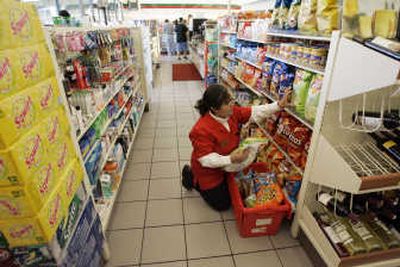Strain on paychecks affecting retailers

NEW YORK – The calculus of living paycheck to paycheck in America is getting harder.
What used to last four days might last half that long now. Pay the gas bill, but skip breakfast. Eat less for lunch so the kids can have a healthy dinner.
Across the nation, Americans are increasingly unable to stretch their dollars to the next payday as they juggle higher rent, food and energy bills. It’s starting to affect middle-income working families as well as the poor and has reached the point of affecting day-to-day calculations of merchants such as Wal-Mart Stores Inc., 7-Eleven Inc. and Family Dollar Stores Inc.
While economists debate whether the country is headed for a recession, some say financial stress is already the worst since the last downturn at the start of this decade.
From Family Dollar to Wal-Mart, merchants have adjusted their product mix and pricing accordingly. Sales data show a marked and more prolonged drop in spending in the days before shoppers get their paychecks, when they buy only the barest essentials before splurging around payday.
“It’s pretty pronounced,” said Kiley Rawlins, a spokeswoman at Family Dollar. “It seems like to us, customers are running out of food products, paper towels sooner in the month.”
Wal-Mart, the world’s largest retailer, said the imbalance in spending before and after payday in July was the biggest it has ever seen, though the drop-off wasn’t as steep in August.
And 7-Eleven says its grocery sales have jumped 12 percent to 13 percent over the past year, compared with only slight increases for non-necessities like gloves and toys. Shoppers can’t afford to load up at the supermarket and are going to the most convenient places to buy emergency food items like milk and eggs.
Industry analysts and some economists fear the strain will get worse as people are hit with higher home heating bills this winter and mortgage rates go up.
In the meantime, rising costs show no signs of abating.
Gas prices hit a record nationwide average of $3.23 per gallon in late May before receding a little, though prices are expected to soar again later this year. Food costs have increased 4.5 percent over the past 12 months, partly because of higher fuel costs. Egg prices were 44 percent higher, while milk was up 21.3 percent over the past 12 months to nearly $4 a gallon, according to the Bureau of Labor Statistics.
The average family of four is spending anywhere from $7 to $10 extra a week – $40 more a month – on groceries alone, compared with a year ago, according to retail consultant Burt Flickinger III.
And while overall wage growth is a solid 4.1 percent over the past 12 months, economists say the increases are mostly for the top earners.
Retailers started noticing the strain in late spring and early summer as they were monitoring the spending around the paycheck cycle.
Wal-Mart and Family Dollar key on the first week of the month, when government checks like Social Security and public assistance generally hit consumers’ mailboxes.
7-Eleven, whose customers are more diverse, looks at paycheck cycles in specific markets dominated by a major employer, such as General Motors in Detroit, to discern trends in shopping.
To economize, shoppers are going for less expensive food.
“They’re buying more peanut butter and pasta. And they’re going for hamburger meat,” Flickinger, the retail consultant, said. “They’re trying to outsmart the store by looking for deep discounts at the end of the month.”